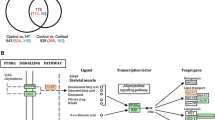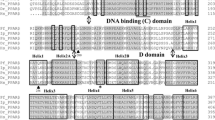Abstract
Peroxisome proliferator-activated receptors (PPARs) are members of the superfamily of nuclear hormone receptors involved in embryo development and differentiation of several tissues in mammals. The aim of the present study was to investigate the possible differential expression of the three PPAR subtypes (PPARα, PPARβ, and PPARγ) in relation to gender and developmental stage in zebrafish. For this purpose PPAR expression was assessed by immunohistochemistry in 7-day-old larvae, 1-month-old juveniles, and 1-year-old adults. Additionally, the activity of peroxisomal acyl-CoA oxidase (AOX), a gene regulated by PPARs, and the volume density of catalase-immunolabeled liver peroxisomes (VVP) was examined. No significant gender-related differences were detected in the tissue distribution of the three PPAR subtypes or in peroxisomal AOX activity and VVP. The percentage of PPARβ-positive hepatocytes was significantly higher in females than in males suggesting a specific regulatory role of this subtype in female zebrafish. The three PPAR subtypes were already expressed at the larval stage, with a similar tissue distribution pattern to that found in adults. For all stages, PPARα and PPARγ were expressed at higher levels than PPARβ, and PPARβ immunolabeling was stronger in juveniles than in larval or adult stages. The percentages of hepatocyte nuclei immunolabeled for PPARs was higher in early developmental stages than in adults, similarly to AOX activity and VVP. In conclusion, our results indicate that PPAR expression, the activity of its target gene AOX, and peroxisomal biogenesis are developmentally modulated in zebrafish.






Similar content being viewed by others
References
Andersen Ø, Eijsink VGH, Thomassen M (2000) Multiple variants of the peroxisome proliferator-activated receptor (PPAR)γ are expressed in the liver of Atlantic salmon (Salmo salar). Gene 255:411–418
Aperlo C, Pognonec P, Saladin R, Auwerx J, Boulukos KE (1995) cDNA cloning and characterization of the transcriptional activities of the hamster peroxisome proliferator-activated receptor haPPARα. Gene 162:297–302
Beier K, Völkl A, Hashimoto T, Fahimi HD (1988) Selective induction of peroxisomal enzymes by the hypolipidemic drug bezafibrate. Detection of modulations by automatic image analysis in conjunction with immunoelectron microscopy and immunoblotting. Eur J Cell Biol 46:383–393
Beier K, Völkl A, Metzger C, Mayer D, Bannasch P, Fahimi HD (1997) Hepatic zonation of the induction of cytochrome P450 IV A, peroxisomal lipid β-oxidation enzymes and peroxisome proliferation in rats treated with dehydroepiandrosterone (DHEA). Evidence of distinct zonal and sex-specific differences. Carcinogenesis 18:1491–1498
Braissant O, Wahli W (1998) Differential expression of peroxisome proliferator-activated receptor-α, -β, and -γ during rat embryonic development. Endocrinology 139:2748–2754
Braissant O, Foufelle F, Scotto C, Dauça M, Wahli W (1996) Differential expression of peroxisome proliferator-activated receptors (PPARs): tissue distribution of PPAR-α, -β, and -γ in the adult rat. Endocrinology 137:354–366
Cajaraville MP, Cancio I, Ibabe A, Orbea A (2003) Peroxisome proliferation as a biomarker in environmental pollution assessment. Microsc Res Tech 61:191–202
Culling CFA, Barkoczy B (1972) Paraffin embedding of bony tissues followed by decalcification of the layer to be sectioned. Stain Technol 47:219–220
Dreyer C, Ellinger-Ziegelbauer H (1996) Retinoic acid receptors and nuclear orphan receptors in the development of Xenopus laevis. Int J Dev Biol 40:255–262
Dreyer C, Krey G, Keller H, Givel F, Helftenbein G, Wahli W (1992) Control of the peroxisomal β-oxidation pathway by a novel family of nuclear hormone receptors. Cell 68:879–887
Ekker M, Akimenko MA (1991) Le poisson zèbre (Danio rerio) un modèle en biologie du développement. Médecine/Sciences 7:553–560
Elbrecht A, Chen Y, Cullinan CA, Hayes N, Leibowitz MD, Moller DE, Berger J (1996) Molecular cloning, expression and characterization of human peroxisome proliferator activated receptors γ1 and γ2. Biochem Biophys Res Commun 224:431–437
Escrivá H, Safi R, Hänni C, Langlois MC Saumitou-Laprade P, Stehelin D, Caprón A, Pierce R, Laudet V (1997) Ligand binding was acquired during evolution of nuclear receptors. Evolution 97:6803–6809
Escrivá H, Robinson M, Laudet V (1999) Evolutionary biology of the nuclear receptor superfamily. In: Picard D (ed) Nuclear receptors, a practical approach. Oxford University Press, Oxford, pp 1–28
Fahimi HD, Cajaraville MP (1995) Induction of peroxisome proliferation by some environmental pollutants and chemicals in animal tissues. In: Cajaraville MP (ed) Cell biology in environmental toxicology. University of the Basque Country Press Service, Bilbo, pp 221–255
Fajas L, Fruchart JC, Auwerx J (1998) Transcriptional control of adipogenesis. Curr Opin Cell Biol 10:165–173
Gebel T, Arand M, Oesch F (1992) Induction of peroxisome proliferator activated receptor by fenofibrate in rat liver. FEBS Lett 309:37–40
Grimaldi PA (2001) The roles of PPARs in adipocyte differentiation. Prog Lipid Res 40:269–281
Grindflek E, Sundvold H, Klungland H, Lien S (1998) Characterisation of porcine peroxisome proliferator-activated receptors γ1 and γ2: detection of breed and age differences in gene expression. Biochem Biophys Res Commun 249:713–718
Guardiola-Diaz HM, Rehnmark S, Usuda N, Albrektsen T, Feltkamp D, Gustafsson J-A, Alexson SEH (1999) Rat peroxisome proliferator-activated receptors and brown adipose tissue function during cold acclimatization. J Biol Chem 274:23368–23377
Holden PR, Tugwood JD (1999) Peroxisome proliferator-activated receptor alpha: role in rodent liver cancer species differences. J Mol Biol 22:1–8
Ibabe A, Grabenbauer M, Baumgart E, Fahimi HD, Cajaraville MP (2002) Expression of peroxisome proliferator-activated receptors (PPARs) in zebrafish (Danio rerio). Histochem Cell Biol 118:231–239
Ibabe A, Grabenbauer M, Baumgart E, Völkl A, Fahimi HD, Cajaraville MP (2004) Expression of peroxisome proliferator-activated receptors in the liver of gray mullet (Mugil cephalus). Acta Histochem 106:11–19
Jalouli M, Carlsson L, Ameen C, Linden D, Ljungberg A, Michalik L, Wahli W, Oscarsson J (2003) Sex difference in hepatic peroxisome proliferator-activated receptor alpha expression: influence of pituitary and gonadal hormones. Endocrinology 144:101–109
Keller JM, Collet P, Bianchi A, Huin C, Bouillaud-Kremarik P, Becuwe P, Schohn H, Domenjoud L, Dauça M (2000) Implications of peroxisome proliferator-activated receptors (PPARs) in development, cell life status and disease. Int J Dev Biol 44:429–442
Kersten S, Desvergne B, Wahli W (2000) Roles of PPARs in health and disease. Nature 405:421–424
Kliewer SA, Forman BM, Blumberg B, Ong ES, Borgmeyer U, Mangelsdorf DJ, Umesono K, Evans RM (1994) Differential expression and activation of a family of murine peroxisome-activated receptors. Proc Natl Acad Sci U S A 91:7355–7359
Leaver MJ, Wright J, George SG (1997) Structure and expression of a cluster of glutathione S-transferase genes from a marine fish, the plaice (Pleuronectes platessa). Biochem J 321:405–412
Leaver MJ, Wright J, George SG (1998) A peroxisomal proliferator-activated receptor gene from the marine flatfish, the plaice (Pleuronectes platessa). Mar Environ Res 46:75–79
Lee SS, Pineau T, Drago J, Lee EJ, Owens JW, Kroetz DL, Fernandez-Salguero PM, Westphal H, Gonzalez FJ (1995) Targeted disruption of the α isoform of the peroxisome proliferator-activated receptor gene in mice results in abolishment of the pleiotropic effects of peroxisome proliferators. Mol Cell Biol 15:3012–3022
Lefebvre AM, Paulweber B, Fajas L, Woods J, McCrary C, Colombel JF, Najib J, Fruchart JC, Datz C, Vidal H, Desreumaux P, Auwerx J (1999) Peroxisome proliferator-activated receptor gamma is induced during differentiation of colon epithelium cells. J Endocrinol 162:331–340
Lemberger T, Braissant O, Juge-Aubry C, Keller H, Saladin R, Staels B, Auwerx J, Burger AG, Meier CA, Wahli W (1996) PPAR tissue distribution and interactions with other hormone-signaling pathways. Ann N Y Acad Sci 804:231–251
Lowry OH, Rosebrough NJ, Farr AL, Randall RJ (1951) Protein measurement with the folin phenol reagent. J Biol Chem 193:265–275
Ma H, Tam QT, Kolattukudy PE (1998) Peroxisome proliferator-activated receptor γ1 (PPAR-γ1) as a major PPAR in a tissue in which estrogen induces peroxisome proliferation. FEBS Lett 434:394–400
Mansén A, Guardiola-Diaz H, Rafter J, Branting C, Gustafsson JA (1996) Expression of the peroxisome proliferator-activated receptor (PPAR) in the mouse colonic mucosa. Biochem Biophys Res Commun 222:844–851
Michalik L, Desvergne B, Tan NS, Basu-Modak S, Escher P, Rieusset J, Peters JM, Kaya G, Gonzalez FJ, Zakany J, Metzger D, Chambon P, Duboule D, Wahli W (2001) Impaired skin wound healing in peroxisome proliferator-activated receptor (PPAR)α and PPARβ mutant mice. J Cell Biol 154:799–814
Michalik L, Desvergne B, Dreyer C, Gavillet M, Laurini RN, Wahli W (2002) PPAR expression and function during vertebrate development. Int J Dev Biol 46:105–114
Panadero M, Herrera E, Bocos C (2000) Peroxisome proliferator-activated receptor-α expression in rat liver during postnatal development. Biochimie 82:723–726
Panadero M, Vidal H, Herrera E, Bocos C (2001) Nutritionally induced changes in the peroxisome proliferator-activated receptor-α gene expression in liver of suckling rats are dependent on insulinaemia. Arch Biochem Biophys 394:182–188
Peters JM, Lee SST, Li W, Ward JM, Gavrilova G, Everett C, Reitman ML, Hudson LD, Gonzalez FJ (2000) Growth, adipose, brain, and skin alteration resulting from targeted disruption of the mouse peroxisome proliferator-activated receptor β/δ. Mol Cell Biol 20:5119–5128
Ren B, Thelen AP, Peters JM, Gonzalez FJ, Jump DB (1997) Polyunsaturated fatty acid suppression of hepatic fatty acid synthase and S14 gene expression does not require peroxisome proliferator-activated receptor α. J Biol Chem 272:26827–26832
Rivier M, Safonova I, Lebrun P, Griffiths CEM, Ailhaud G, Michel S (1998) Differential expression of peroxisome proliferator-activated receptor subtypes during the differentiation of human keratinocytes. J Invest Dermatol 111:1116–1121
Roberts-Thomson SJ (2000) Peroxisome proliferator-activated receptors in tumorigenesis: targets of tumour promotion and treatment. Immunol Cell Biol 78:436–441
Rosenberger TA, Hovda JT, Peters JM (2002) Targeted disruption of peroxisomal proliferator-activated receptor beta (delta) results in distinct gender differences in mouse brain phospholipid and esterified FA levels. Lipids 37:495–500
Ruyter B, Andersen Ø, Dehli A, Farrants Akö, Gjøen T, Thomassen MS (1997) Peroxisome proliferator activated receptors in Atlantic salmon (Salmo salar): effects on PPAR transcription and acyl-CoA oxidase activity in hepatocytes by peroxisome proliferators and fatty acids. Biochim Biophys Acta 1348:331–338
Sanguino E, Ramón M, Michalik L, Wahli W, Alegret M, Sánchez RM, Vázquez-Carrera M, Laguna JC (2004) Lack of hypotriglyceridemic effect of gemfibrozil as a consequence of age-related changes in rat liver PPARα. Biochem Pharmacol 67:157–166
Schoonjans K, Peinado-Onsurbe J, Lefebvre AM, Heyman RA, Briggs M, Deeb S, Staels B, Auwerx J (1996) The peroxisome proliferator activated receptors (PPARs) and their effects on lipid metabolism and adipocyte differentiation. Biochim Biophys Acta 1302:93–109
Schultz R, Yan W, Toppari J, Völkl A, Gustafsson J-A, Pelto-Huikko M (1999) Expression of peroxisome proliferator-activated receptor α messenger ribonucleic acid and protein in human and rat testis. Endocrinology 140:2968–2975
Small GM, Burdett K, Connock MJA (1985) Sensitive spectrophotometric assay for peroxisomal acyl-CoA oxidase. Biochem J 227:205–210
Sokal RR, Rohlf FJ (1995) Biometry, 3rd edn. Freeman, New York
Stier H, Fahimi HD, Van Veldhoven PP, Mannaerts GP, Völkl A, Baumgart E (1998) Maturation of peroxisomes in differentiating human hepatoblastoma cells (HepG2): possible involvement of the peroxisome proliferator-activated receptor alpha (PPAR alpha). Differentiation 64:55–66
Walczak P, Tontonoz P (2002) PPARadigms and PPARadoxes: expanding roles for PPARγ in the control of lipid metabolism. J Lipid Res 43:177–186
Weibel ER (1979) Stereological methods, vol I. Academic, London
Acknowledgements
This study has been funded by the University of the Basque Country through a grant to consolidated research groups, by the Spanish Ministry of Science and Technology through project AMB99-0324 (CICYT), by the Spanish Ministry of Education and Culture through a predoctoral fellowship to Arantza lbabe, and by the European Commission (Research Directorate General, Environment Programme-Marine Ecosystems) through the BEEP project “Biological Effects of Environmental Pollution in Marine Coastal Ecosystems” (contract EVK3-CT2000-00025). The BEEP project is part of the EC IMPACTS cluster. We are indebted to Prof. H.D. Fahimi (University of Heidelberg, Germany) for the kind gift of the rabbit anti-guinea pig liver catalase antibody and for support during this study.
Author information
Authors and Affiliations
Corresponding author
Rights and permissions
About this article
Cite this article
Ibabe, A., Bilbao, E. & Cajaraville, M.P. Expression of peroxisome proliferator-activated receptors in zebrafish (Danio rerio) depending on gender and developmental stage. Histochem Cell Biol 123, 75–87 (2005). https://doi.org/10.1007/s00418-004-0737-2
Accepted:
Published:
Issue Date:
DOI: https://doi.org/10.1007/s00418-004-0737-2




